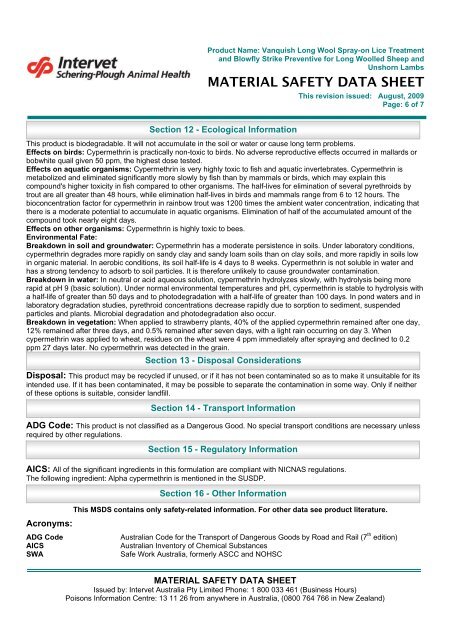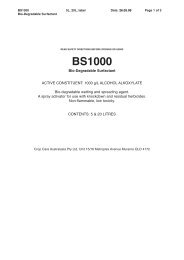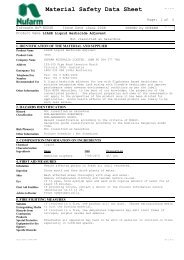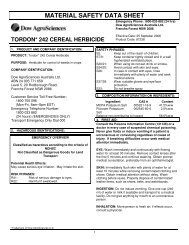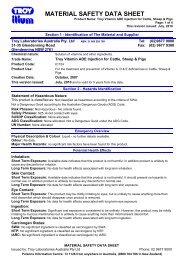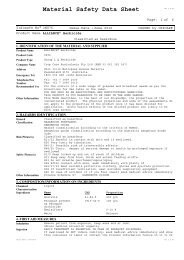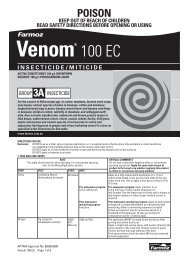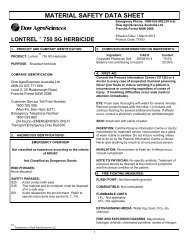995028 Vanquish.MSDS - Agsure
995028 Vanquish.MSDS - Agsure
995028 Vanquish.MSDS - Agsure
- No tags were found...
You also want an ePaper? Increase the reach of your titles
YUMPU automatically turns print PDFs into web optimized ePapers that Google loves.
Product Name: <strong>Vanquish</strong> Long Wool Spray-on Lice Treatmentand Blowfly Strike Preventive for Long Woolled Sheep andUnshorn LambsMATERIAL SAFETY DATA SHEETThis revision issued: August, 2009Page: 6 of 7This product is biodegradable. It will not accumulate in the soil or water or cause long term problems.Effects on birds: Cypermethrin is practically non-toxic to birds. No adverse reproductive effects occurred in mallards orbobwhite quail given 50 ppm, the highest dose tested.Effects on aquatic organisms: Cypermethrin is very highly toxic to fish and aquatic invertebrates. Cypermethrin ismetabolized and eliminated significantly more slowly by fish than by mammals or birds, which may explain thiscompound's higher toxicity in fish compared to other organisms. The half-lives for elimination of several pyrethroids bytrout are all greater than 48 hours, while elimination half-lives in birds and mammals range from 6 to 12 hours. Thebioconcentration factor for cypermethrin in rainbow trout was 1200 times the ambient water concentration, indicating thatthere is a moderate potential to accumulate in aquatic organisms. Elimination of half of the accumulated amount of thecompound took nearly eight days.Effects on other organisms: Cypermethrin is highly toxic to bees.Environmental Fate:Breakdown in soil and groundwater: Cypermethrin has a moderate persistence in soils. Under laboratory conditions,cypermethrin degrades more rapidly on sandy clay and sandy loam soils than on clay soils, and more rapidly in soils lowin organic material. In aerobic conditions, its soil half-life is 4 days to 8 weeks. Cypermethrin is not soluble in water andhas a strong tendency to adsorb to soil particles. It is therefore unlikely to cause groundwater contamination.Breakdown in water: In neutral or acid aqueous solution, cypermethrin hydrolyzes slowly, with hydrolysis being morerapid at pH 9 (basic solution). Under normal environmental temperatures and pH, cypermethrin is stable to hydrolysis witha half-life of greater than 50 days and to photodegradation with a half-life of greater than 100 days. In pond waters and inlaboratory degradation studies, pyrethroid concentrations decrease rapidly due to sorption to sediment, suspendedparticles and plants. Microbial degradation and photodegradation also occur.Breakdown in vegetation: When applied to strawberry plants, 40% of the applied cypermethrin remained after one day,12% remained after three days, and 0.5% remained after seven days, with a light rain occurring on day 3. Whencypermethrin was applied to wheat, residues on the wheat were 4 ppm immediately after spraying and declined to 0.2ppm 27 days later. No cypermethrin was detected in the grain.Disposal: This product may be recycled if unused, or if it has not been contaminated so as to make it unsuitable for itsintended use. If it has been contaminated, it may be possible to separate the contamination in some way. Only if neitherof these options is suitable, consider landfill.ADG Code: This product is not classified as a Dangerous Good. No special transport conditions are necessary unlessrequired by other regulations.AICS: All of the significant ingredients in this formulation are compliant with NICNAS regulations.The following ingredient: Alpha cypermethrin is mentioned in the SUSDP.This <strong>MSDS</strong> contains only safety-related information. For other data see product literature.Acronyms:ADG CodeAICSSWASection 12 - Ecological InformationSection 13 - Disposal ConsiderationsSection 14 - Transport InformationSection 15 - Regulatory InformationSection 16 - Other InformationAustralian Code for the Transport of Dangerous Goods by Road and Rail (7 th edition)Australian Inventory of Chemical SubstancesSafe Work Australia, formerly ASCC and NOHSCMATERIAL SAFETY DATA SHEETIssued by: Intervet Australia Pty Limited Phone: 1 800 033 461 (Business Hours)Poisons Information Centre: 13 11 26 from anywhere in Australia, (0800 764 766 in New Zealand)


